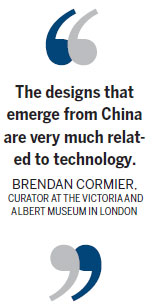Venerable British institution has designs on China

As Victoria and Albert prepares to open Shenzhen museum, curator sees great things ahead for country
China is rapidly emerging as one of the world's best places for new designs that shape lives functionally and artistically, says Brendan Cormier, a curator at the Victoria and Albert Museum in London, who is the creative brain behind the first exhibition at the new V&A Gallery in Shekou, Shenzhen.
"The designs that emerge from China are very much related to technology," he says. "They are very simple, effective, clever and acknowledge slight variations. In Shenzhen the design is mostly electronic oriented; they are very much function led."
The V&A Gallery is a part of the museum in Shekou, which V&A is organizing in collaboration with China Merchants Group. The museum is in the Seaworld Arts and Culture Center, designed by the Japanese architecture studio Maki & Associates, and is due to open in early 2017. Shekou is an industrial zone in Shenzhen.
For the first exhibition to be shown in the V&A Gallery, 250 objects have been chosen from the V&A's permanent collection that invite the viewer to think of design in different ways.
For example, there are billiard balls made from ivory from the 19th century, which are cut in half, with religious stories carved inside on the flat surfaces.
"The ivory is a morally questionable material, which reflects some historical background at the time, as in the 19th century many elephants were being killed and there was a shortage of ivory," Cormier says.
"When the billiard balls eventually wear out after being used so much, they are unusable as balls, so people turn them into art objects with different value.

"This is an example of up-cycling, as we call it now. The concept is popular because we are concerned about the environment, but in the 19th century it was also very popular because resources were scarce."
He says he hopes the gallery's exhibition will allow viewers to broaden their understanding of design, and to ask questions they have not thought of before.
For the V&A to open a gallery in Shekou was a big decision, and Cormier says one of the key reasons is the V&A's own sense of responsibility to bring its collections to viewers around the world, because many of the objects it has are in storage and are not shown.
Another reason, which explains the choice of Shekou, is the opportunity to explore Shenzhen's local design market and collect objects for the V&A's permanent collection.
"We want to explore how personal and cultural values drive design, and we hope the exhibition will give audiencea tools to value what makes good design," Cormier says.
Items in the collection cover all aspects of design, including fashion, textiles, pottery, glass, plastic, electronics and graphic design.
"We have designs not just from the 20th century but a long time ago, for example with the oldest objects including some Middle Eastern water jars from historical times, up to design today. The world of design we are used to in the 20th century has a lot of mass production objects, but in the past a lot of design is craft made by skilled people, like pottery and jars that are clay-fired."
One object the V&A may pick up is a drone made by DJI, a Chinese technology company founded in 2006 in Shenzhen. It makes commercial and recreational unmanned aerial vehicles for aerial photography and videography.
This drone is not only interesting in its technology, but it also represents society's larger aspirations and explorations on what drones can do, Cormier says.
He cites plans by the e-commerce firm Amazon to develop a drone that can do deliveries, thus avoiding road traffic. In this sense, collecting such objects is a way of documenting history.
"We always collect new things and they will eventually become old. We collect things as they appear, so we document history in an accurate way."
For the viewer, it may take much more effort to see the value of new objects, but from the curator's perspective they are important, he says. "Culturally and socially they have a lot of importance. For example, the Sony Walkman was once the most popular music playing device, and now it is difficult to find a Sony Walkman."
Cormier is making the most of the opportunity to collect design objects from Shenzhen, which is a hub for design and in recent years has gradually attracted an increasing number of foreign designers.
"The newer generation of Chinese designers is very aspirational. It is interesting because few designers are designers. They are entrepreneurs."
The designs of such people are already making a difference to the way people live, he says.
cecily.liu@chinadaily.com.cn
(China Daily European Weekly 11/13/2015 page26)
Today's Top News
- Japan tempting fate if it interferes in the situation of Taiwan Strait
- Stable trade ties benefit China, US
- Experts advocate increasing scope of BRI to include soft power sectors
- New engine powers cargo drone expansion
- China to boost green industry cooperation
- Manufacturing PMI rises in November






























